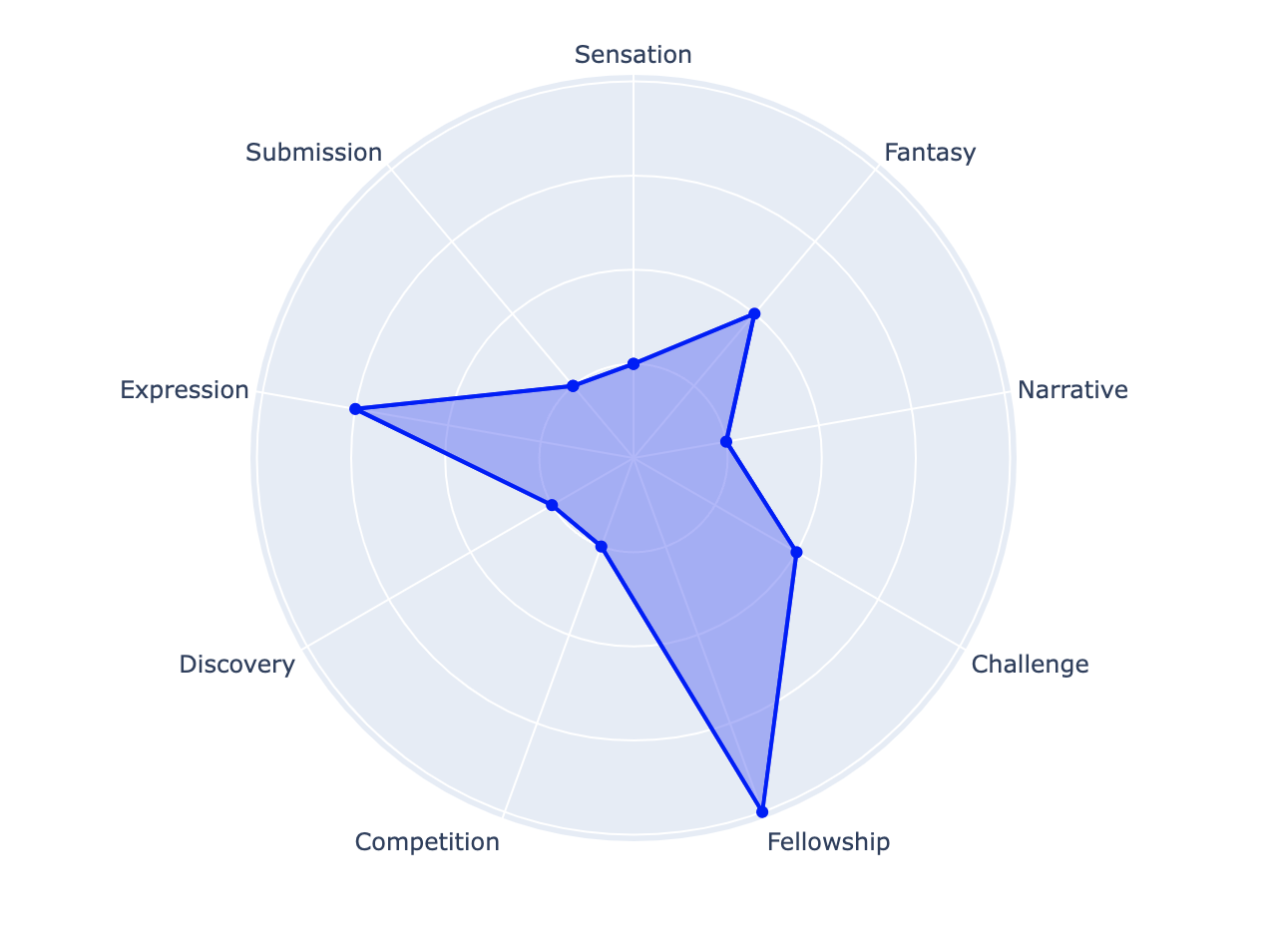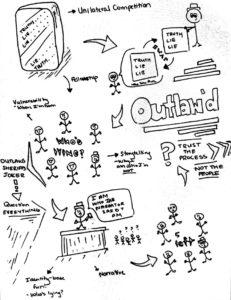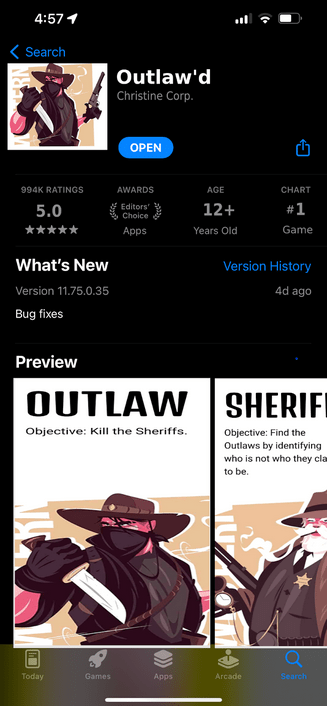Outlaw’d
By Shimea Bridgewater, Alejandro Cid, Nancy Hoang, Manan Rai
Outlaw’d is a lively social deduction game centered around getting to know the people you play with. Take your refined, 21st century self back in time to the wild west, as you are placed in a group of sheriffs with masquerading outlaws and psychos. To survive, you must find out all you can about your fellow players, before the outlaws strike again!
Artists’ Statement
We created Outlaw’d to create instant, deep connections between strangers. The game is designed to completely shatter the ice between people, encouraging them to come out of their shell and share their story in a consensual yet elaborate way. To do this, we combine concepts from two different genres, “Getting to Know You” games and Social Deduction games. Rather than relying on avatars and fantastic identities like in Among Us and Secret Werewolf, we introduce each player’s life story into the character they are playing. In Outlaw’d, some select players are given false life stories and the other players must cooperate to uncover who is not who they say they are. Because of the challenge of trying to identify the masqueraders, players are encouraged to ask each other detailed questions to try to catch each other in their lies. As an auxiliary effect of each player’s will to win, players learn real facts about each other’s lives and they come out of the game with solid foundational knowledge of each other. During our playtests, we found that strangers became fast friends when playing Outlaw’d and were able to loosen up with each other. We even found they were subsequently much more open to, and comfortable, playing other games with each other as they developed a sense of camaraderie and familiarity. Outlaw’d is truly fun for everyone and we are excited to spread this game to more people in the future!
Overview
A game of Outlaw’d can be played with 6-12 players, where one player acts as the Narrator. The remaining players play in one of three roles with unique mechanics and win conditions:
- Sheriffs, the innocent players who are attempting to identify the Outlaws. Sheriffs win if all the Outlaws are eliminated.
- Psycho, a masquerading player who wins if they get voted out.
- Outlaws, masquerading players who can eliminate a player during night rounds, and win if the number of remaining Outlaws matches or exceeds the number of alive non-Outlaws.
Each player shares three facts about themselves with the Narrator before roles are assigned. The Narrator also submits three random facts that may or may not be true for any person on the table. When the game starts, each player is given a role, along with three facts that they must defend:
- Sheriffs and Psychos play as themselves, i.e. their three facts are the original ones that they submitted.
- Outlaws are assigned, at random, three facts from the ones submitted by other Outlaws (if any) and the Narrator, such that no Outlaw plays with their own facts. They must represent the facts they were given as if they are true. All players are aware of the way the facts are redistributed.
A game is divided into rounds (as many as needed until a win condition is reached), and each round is divided into two turns: a Night, and a Day.

During night-time, only the Outlaws wake up, while the non-Outlaws “sleep.” Each Outlaw gets one vote to assign to a non-Outlaw player that they want to eliminate; each night, at most one non-Outlaw member can be eliminated by simple majority (more than 50%) of votes from the Outlaws.
During day-time, everyone awakens, but any eliminated players can no longer participate. Players can now communicate with one-another in a free-form discussion. At the end of discussions, each player gets one vote to assign to any alive player. If a simple majority of votes is achieved for any player, that player is eliminated.
The game begins with a turn of day-time, and ends when any win condition is reached. The Narrator manages the game, ensuring that no rules are broken.
Companion App
Getting to know people is most effectively done in person, but writing facts that people will try to guess the author of isn’t: we don’t want people to make guesses based on the folds on your index cards, or the color of pen you used. We want people to actually learn about each other so they can differentiate fact from fiction about you! Additionally, a lot of the tediousness and impracticality around party games arises out of having to manage physical cards and assign roles. Accordingly, we made a companion app for Outlaw’d, that collects facts from players, assigns them roles, shuffles Outlaws’ facts as needed, and lets everyone see each others’ facts.
We built this as a browser-based webapp, that is functional and available at outlawd.herokuapp.com. The app is primarily functional on mobile devices.
Formal Elements
Players. At least 6 players, where one player acts as the admin/narrator. The relationship between players is mainly team competition (outlaws versus sheriffs), but for the Psycho, the relationship with other players is unilateral competition (Everyone versus the Psycho).
Objectives. The primary objective is to outwit others, since each player is trying to figure out everyone else’s role and survive. The outlaws want to outwit the sheriffs by pretending to be innocent themselves. The sheriffs have to outwit the outlaws by seeing past their lies and correctly vote them out. And the joker has to outwit everyone by coming off as an outlaw so that players may be inclined to vote them out, but not in a very obvious way lest the sheriffs become wary of voting them out, or the outlaws eliminate them to remove competition.
Outcomes. This is a zero sum game, with no ties. Either the sheriffs win by voting out all the outlaws, the outlaws win by being among the last ones standing (the number of outlaws is at least as many as the number of other players), or the psycho wins by being voted out by the other players.
Resources. Everyone’s fact cards, which can be viewed at any time.
Boundaries. There are no physical boundaries. With the webapp, players can play with others online. As for narrative boundaries, players will assume the roles that they are assigned and use those mechanics, but the narrative will largely be guided by the facts that players write, and the stories they share to corroborate those facts.
Rules
The narrator is not allowed to offer any hints or extra information as to who each player is. All outlaws together are able to kill at most one player per night turn. At the end of each day turn, each player must either abstain, or vote for exactly one of the alive players. Players cannot change their votes after they cast them, nor change the facts they are assigned. Only outlaws are allowed to be active during night turns, and no player can participate after being eliminated (either by the outlaws, or by being voted out by the group).
Additionally, groups can make certain rules on their own. These may embellish the game, but aren’t part of the core mechanics. One such rule is adding a time limit to each turn: for instance, 3 minutes per day turn, with 30 seconds of voting time, and 30 seconds per night turn.
Procedures
How Secrets are Shuffled
Each game has one narrator. Randomly list out the outlaws. The first outlaw gets the narrator’s facts, the second outlaw gets the first outlaw’s facts, the third outlaw gets the second’s facts, and so on, till each outlaw ends up with three facts written by another player.
The secrets for all other players are left unshuffled.
Without the Companion App:
- The group chooses a narrator.
- Each player, including the narrator, writes three facts on an index card. For all players except the narrator, these should be true facts about themselves. These are collected by the narrator.
- The narrator assigns roles to each player, write the roles on index cards, and places them face-down in front of the players. The narrator then shuffles the secrets as discussed above, and places one secrets card face-up in front of each player.
- We enter the first day turn, where players can have an initial discussion. This may end based on a time limit stipulated by the group and monitored by the narrator.
- A voting turn is conducted by the narrator. Each player abstains, or points towards another person. If a simple majority is achieved for any player, they are eliminated.
- Next, the narrator tells everyone to sleep and we enter the first night turn.
- During the night phase:
- The narrator tells outlaws to wake up and choose who they want to kill.
- Once the outlaws have chosen their target, they are told to go to sleep again.
- Then, the narrator tells all players to wake up and we enter the day turn.
- During the day phase:
- The narrator will update everyone on who has been killed the night before, potentially through the use of a made up story.
- Players are given time for free-form discussion to try and identify the outlaws, based on whose truth card is not actually their own.
- After all players agree, or after a stipulated time limit is achieved, we enter another voting phase.
- Back to night phase (step 7) and repeat steps 7 through 9 until:
- The number of outlaws is at least as many as the number of other players (Outlaws win).
- All outlaws have been voted out (Sheriffs win).
- The psycho was voted out (Psycho wins).
With the Companion App (Recommended):
- The group chooses a narrator.
- The narrator logs onto the webapp and creates a new lobby. They share the link to the lobby with all other players, who can open the link in any web browser.
- Each player, including the narrator, types three facts into the app. For all players except the narrator, these should be true facts about themselves.
- Once all players have done so, the narrator presses the “Start Game” button on the app, which then automatically assigns roles to players and shuffles the truth cards. After this, all players should be able to see each others’ cards through the app.
- We enter the first day turn, where players can have an initial discussion. This may end based on a time limit stipulated by the group and monitored by the narrator.
- A voting turn is conducted by the narrator. Each player abstains, or points towards another person. If a simple majority is achieved for any player, they are eliminated. The narrator marks the player as being eliminated on the app.
- Next, the narrator tells everyone to sleep and we enter the first night turn.
- During the night phase:
- The narrator tells outlaws to wake up and choose who they want to kill.
- Once the outlaws have chosen their target, they are told to go to sleep again.
- The narrator marks the chosen target as being eliminated on the app.
- Then, the narrator tells all players to wake up and we enter the day turn.
- During the day phase:
- Players can see who was eliminated through the app. The narrator may use a made up story to update everyone on who was eliminated, and to add to the narrative.
- Players are given time for free-form discussion to try and identify the outlaws, based on whose truth card is not actually their own.
- After all players agree, or after a stipulated time limit is achieved, we enter another voting phase.
- Back to night phase (step 8) and repeat steps 8 through 10 until:
- The number of outlaws is at least as many as the number of other players (Outlaws win).
- All outlaws have been voted out (Sheriffs win).
- The psycho was voted out (Psycho wins).
- The narrator marks the game as completed by clicking the “End Game” button on the app.
Types of Fun and Values
We wanted to build a getting to know you game that made it actually fun for people to learn more about others. Accordingly, the core aesthetics of Outlaw’d are fellowship and expression. This is a social game at its core, so fellowship is integral to creating an enjoyable experience. Additionally, we deliver on the expression aesthetics through having narrators craft unique stories to relay information from the night phase; having the outlaws portray new identities (or truths) for which they must create additional, believable information; and through having the psycho take any liberties with their truths to cast doubt on their veracity.
In addition, we prioritize the fantasy and challenge aesthetics, respectively through having players assume the roles of western characters, and through adding a layer of social deduction, where players are constantly trying to outwit one-another.

Mind Map

Testing and Iteration History
Our initial game idea was very different from our final one. We first experimented with a digital maze which a player would traverse blindly, guided by another player who could see. The challenge would be to communicate effectively and get to the end of the maze faster than another team of players. Through our playtests we found that this blind maze game didn’t provide enough excitement for the players through obstacles. Essentially, the blind player would follow simple instructions without being able to express any skill or strategy.
Based on feedback from the playtests, we modified the idea to use a blindfolded digital racing game, which would add interesting obstacles, pace, and skill expression to the maze. The blind player would drive the car through the course while avoiding obstacles and not falling off, using the seeing player’s guidance to complete laps around the racetrack in the least amount of time. After creating a multiplayer Godot game and conducting extensive playtesting for our prototype, we found that blind racing was too difficult for the blinded player and too frustrating for the seeing player. Players would repeatedly fall off on the first turn of the course, unable to complete a single lap. Given the time constraints for the project, in place of further refining the prototype to achieve a balanced difficulty, we decided to pivot to a “getting to know you” game, inspired by games like truth or dare, two truths and a lie, and deduction games like mafia and Among Us, and Outlaw’d was born.
Three main playtests were performed for Outlaw’d. In the original game, every player but the gamemaster was asked to write two truths and a lie on a piece of paper. Afterwards, all sheets were collected by the gamemaster and shuffled. The objective of the game was for the Outlaws to identify which paper belonged to the Sheriff. The objective of the Sheriff was to kill someone by guessing which statement was a lie for any other participant. The objective for the Joker (later renamed ‘Psycho’ to better fit the theme, based on feedback about the roles being confusing) was to get voted out. Due to the clear incentives for the Outlaws to reveal their cards and the ratio of Outlaws to Sheriffs and Joker, the game was heavily unfavorable for the Sheriff. All the Outlaws could reveal their cards and quickly identify all the Sheriffs and potentially the Joker. To solve this problem we simplified the rules, having each player write down three short truths about themself on a paper, but keeping that paper. Then, the gamemaster would secretly swap the sheriff’s card with a card holding three truths invented by the gamemaster. The sheriff would have to create a fake story for their facts or risk getting voted out. This version of the game worked far better, as players would heavily doubt each others’ stories, often resulting in an Outlaw being voted out initially. This rebalanced the game to a close to optimal level, and provided the “getting to know you” factor we were hoping for. Players spent a lot of time analyzing each others’ stories, thus getting to know each other very deeply.
For the last iteration of Outlaw’d, we moved the player role and identity cards on a digital platform. This helped players maintain secrecy and avoided the possibility of being outed for one’s handwriting, or the way the index card was folded. In addition, this provided players with a clear explanation of their roles at the beginning of a game, in order to avoid confusion. We also found that having the sheriff be the person who eliminated players was confusing for players, who generally assumed that the outlaw would play the seemingly villainous role. Accordingly, we reversed roles to instead have the outlaws infiltrating the sheriffs. In our final playtest, we found the game was balanced and there was a lower probability that someone could identify each other’s roles based on out-of-game factors like handwriting.
Companion App
Our final app has a Flask server and React frontend, hosted through Heroku. Our first design iteration was simply a single-page app with truth cards, where the card itself would show the user’s assigned role. But the app looked quite bland, and a single-page one provided limited functionality for multiple players to add their secrets. Accordingly, we switched to a better looking app with separate pages to add secrets and to see the assigned role, along with illustrations for the roles. Our next iteration switched to better, consistent illustrations across the app.

The final iteration put it all together into a complete, functioning app with a consistent theme and better graphics.

App Store Page



